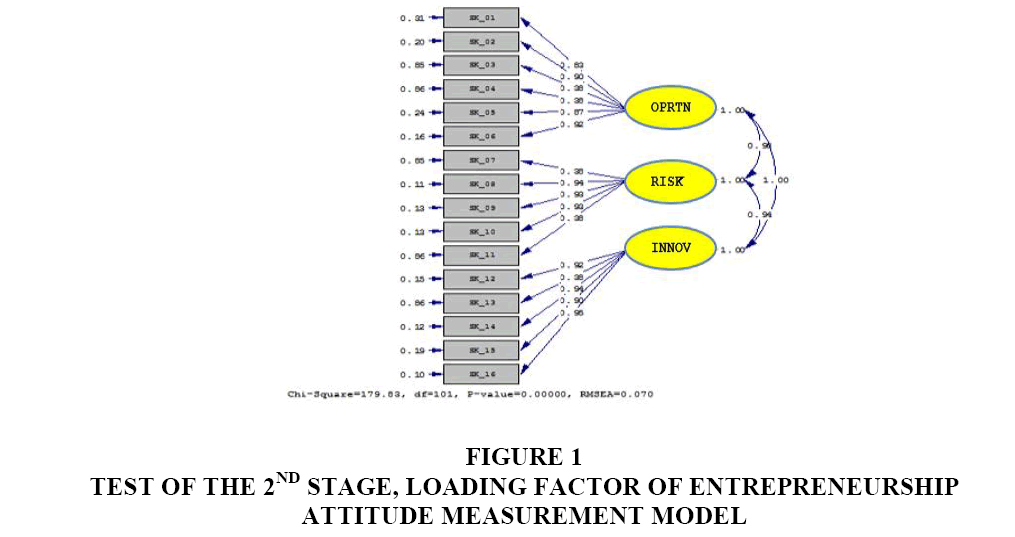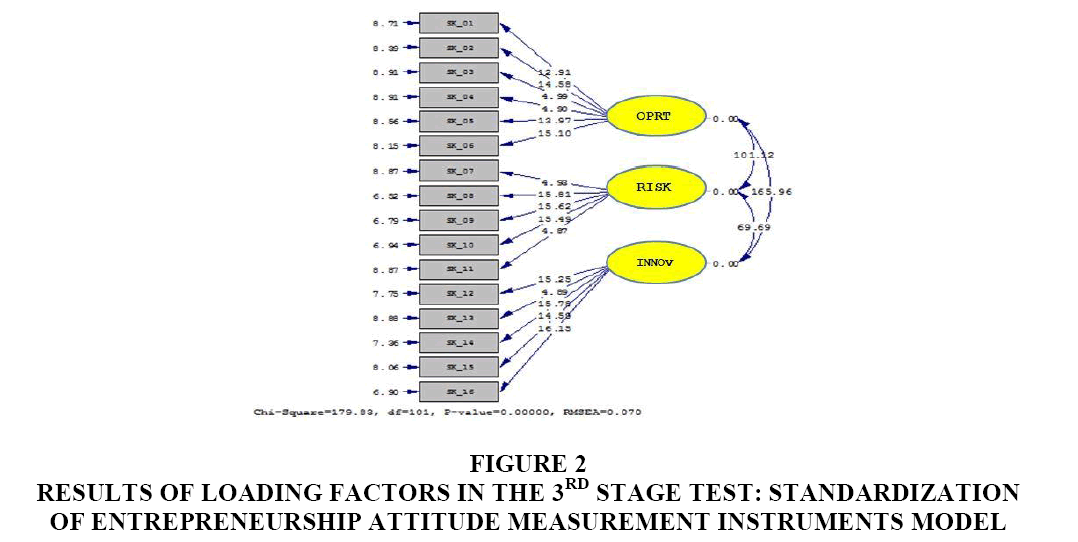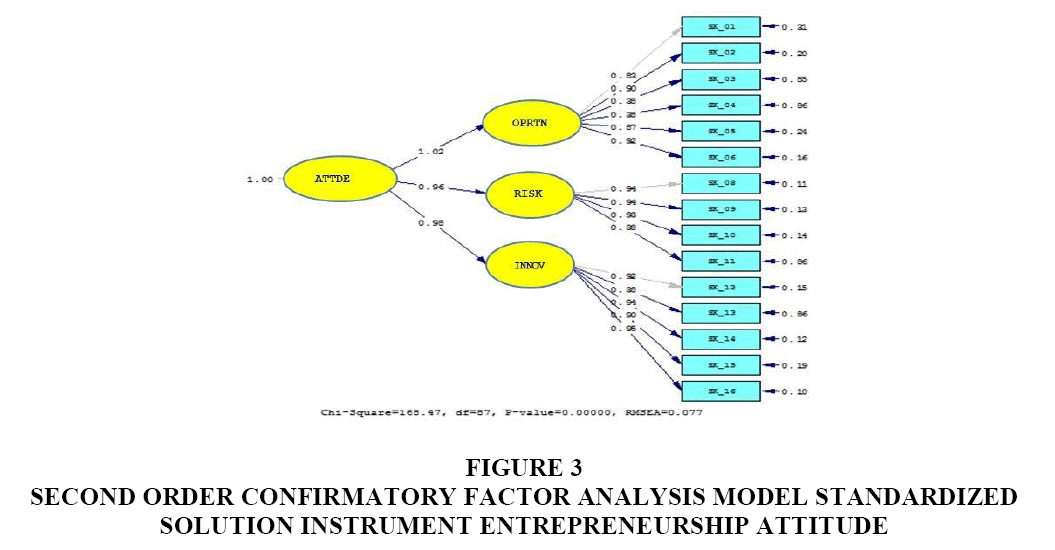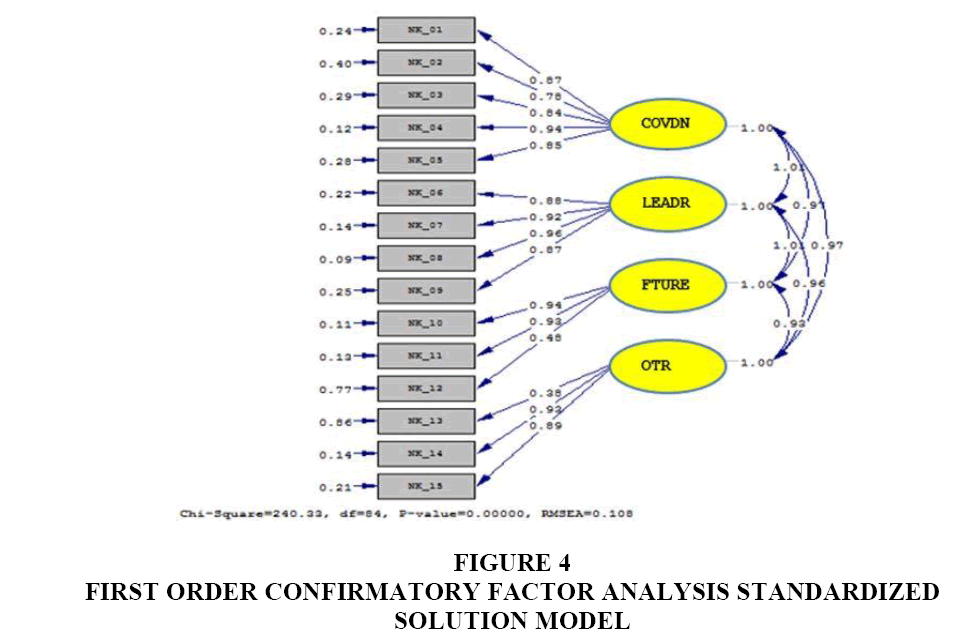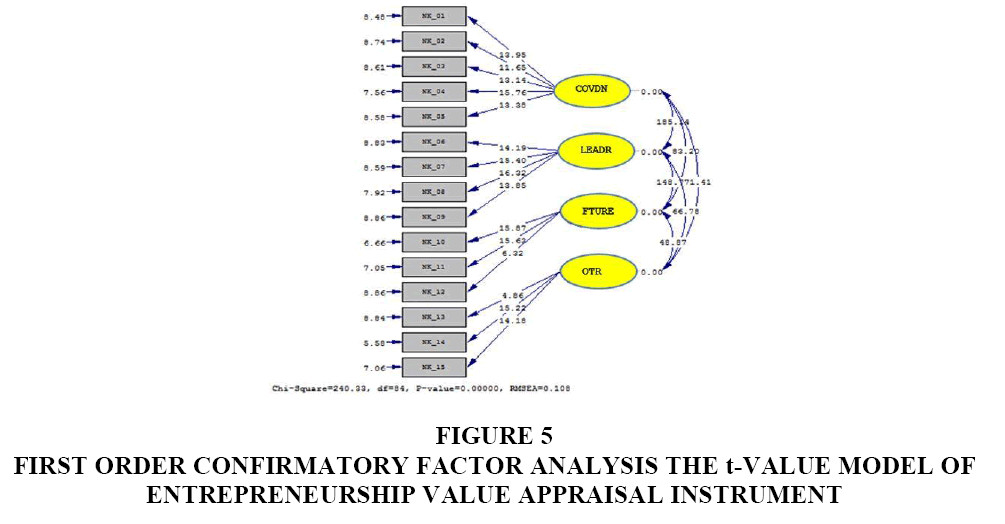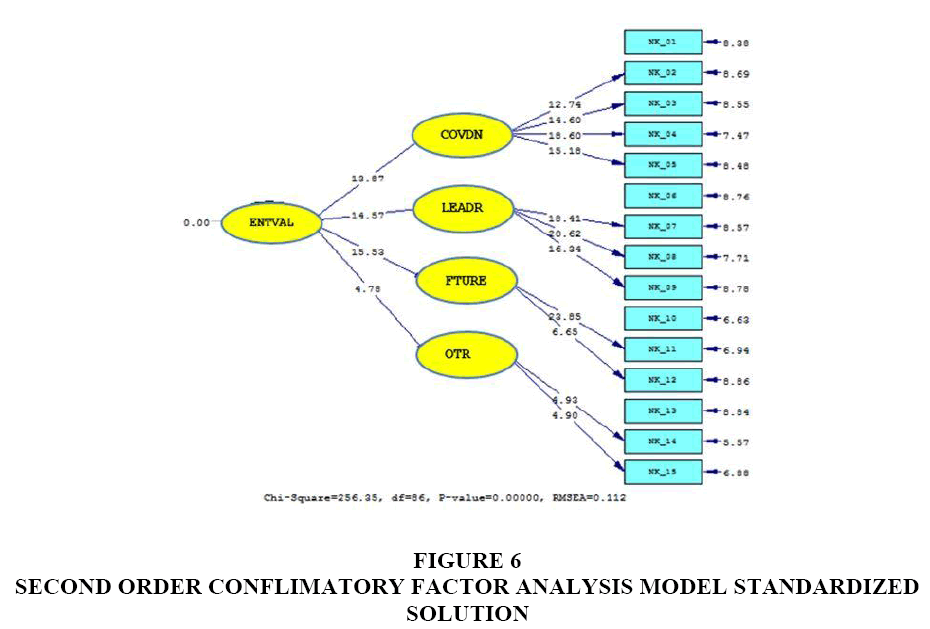Research Article: 2018 Vol: 21 Issue: 4
Development of an Assessment Instrument of Affective Domain for Entrepreneurship in Senior High School
Ari Saptono, State University of Jakarta
Suparno, State University of Jakarta
Safinatun Najah, State University of Jakarta
Abstract
This study aims to produce valid and reliable assessment instruments to measure the affective domain of entrepreneurial learning in high school students. Measurement of entrepreneurial education tends to be in the cognitive and psychomotor domains, whereas entrepreneurial attitudes and mentality are fundamental and can be measured on affective domains. With the population of 630 11th grade students in Jakarta entrepreneurial workshop program, with a sample of 210 respondents with a random sampling technique. Limited testing is done, 30 students in the first trial by testing the validity and reliability of Alpha Cronbach and standardizing the instrument to 160 people for the second test to get the value of the validity and reliability of the entrepreneurial assessment instrument, and the third stage test for instrument standardization by measuring consistency, that met the Goodness of Fit criteria. The resulting instrument can be used to assess the affective domain of entrepreneurship learning in high school students, Dimensions entrepreneurial attitude indicators:
1. Business Opportunities: Reading business opportunity, Capturing business opportunities and Leveraging business opportunities.
2. Risks of business: Entrepreneurship failure, Ability to manage time.
3. Innovation: The ability to innovate, Ability to develop business.
Dimensions value of entrepreneurship indicator:
1. Look confident: Be independent, know your abilities.
2. Leadership: Be disciplined, Respect the opinions of others, Ability to find ideas.
3. Future orientation: Motivation for the future, Future planning.
4. Orientation on assignments and results: Accuracy in gathering assignments, working on tasks with your abilities.
Keywords
Affective Domain, Entrepreneurship, Instrument Development, Learning Assessment.
Introduction
Indonesia is the country with the fourth largest population after China, India and the United States as many as 251,543,400 inhabitants. The richness of nature and the diversity of tribes and cultures became a vital asset owned by Indonesia.
Natural wealth owned by Indonesia has not been able to free Indonesia from economic problems. For example, the issue of poverty that reached 10.7%. In addition to poverty, Indonesia is also faced with unfinished unemployment problems. The growing number of people while the number of available employment is limited makes the unemployment rate in Indonesia is still high.
The government continues to push the unemployment rate. One way is to instill and float the soul and entrepreneurship interest in the community. The high percentage of entrepreneurs in a country can be a reference for economic development. Developed countries have a far greater number of entrepreneurs than developing countries and emerging countries (Vivarelli, 2012; Hendro, 2011). Entrepreneurs in Indonesia are currently only 1.5% of the total population. Indonesia still needs 1.7 million entrepreneurs to reach two percent. While in ASEAN countries recorded Singapore has 7% entrepreneurship, Malaysia as much as 5%, Thailand 4.5% and Vietnam has 3.3% of entrepreneurs of the total population.
The underdevelopment of entrepreneurs in Indonesia is caused by certain attitudes, mindsets, or judgments in society (Astamoen, 2008). Unlike what happened in developed countries like America. They have a great desire to open their business opportunities. The desire to succeed and accumulate wealth from the company he founded. In another aspect, the courage to entrepreneurship is also encouraged by school teachers and schools that provide entrepreneurial subjects. The learning materials are packed as attractive as possible to cultivate the interest of entrepreneurship students. This happened to MIT alumni, Harvard University and other colleges (Alma, 2011).
The growth of interest in entrepreneurship also needs to be instilled early in the child. One of the most effective places to foster entrepreneurship interest is through education. According to researcher, entrepreneurship education will be able to generate a large national impact if this entrepreneurship education can generate four million new entrepreneurs over the next 25 years (Of & Japanese, 2012).
Schools as educational institutions are expected to be able to form independent young entrepreneurs. According to Bandura in the social learning theory provides an understanding of predictions, and changes in human behavior through interactions between humans, behavior, and the environment (Bandura, 1971; Bandura & R.H. Walters, 1963). The school environment is important to be designed by presenting real problems and future challenges that students will face. Entrepreneurial learning can be carried out contextually with the problem-based learning, discovery, or project-based learning method so that students can form knowledge, understanding, and alternative entrepreneurial practices.
The affective domain in entrepreneurship learning is fundamental to be developed and evaluated with dimensions including attitudes and values in a person. In Theory Reasoned Action, a person's intention towards behavior is formed by two main factors, namely certain behavioral attitudes and subjective norms. Attitude is an evaluation or evaluation of a positive or negative person against some beliefs about a particular object (Fishbein and Ajzen, 1975). Theory of Planned Behavior, an extension of the theory, reasoned action adds perceived behavioral control which is the perception of ease or difficulty in fulfilling behavioral interests (Ajzen, 1991). The importance of attitudes and measurements is developed by Azwar that attitude is a phenomenon that arises in addition to being determined by the state of the object being faced also determined by experience.
Learning Value in students, as well as the provision of entrepreneurship, is critical. Entrepreneurial values with self-knowledge, imagination, practical knowledge, search skills, foresight, computational skills, communication skills are the analysis of curriculum development and evaluation needs. According to Robert D. Hisrich, Entrepreneur is the process of creating something new with value by devoting the Necessary time and effort, assuming, the Accompanying financial, psychic, and social risk, and receiving the resulting rewards of monetary and personal satisfaction and independence.
The 2013 curriculum in Indonesia contains the subjects of Workshops and Entrepreneurship contained in lessons at equivalent high school level (Pendidikan et al., 2013). This is realized as an effort to foster the entrepreneurship spirit in high school students as stated in one of the learning objectives of the workshop and entrepreneurship. Students are not only prepared to master science alone but also need to be prepared to see and take advantage of opportunities that exist around. In other words, students have been taught to open opportunities and opportunities for themselves and others.
Learning has three important aspects that are done by the teacher that is the preparation stage, teaching, and evaluation. This study focused on the evaluation of learning by educators to learners. Assessment by the teacher is a form of assessment that refers to the evaluation of the domain of knowledge, attitudes, and skills in a balanced manner. But in reality on the ground shows that many teachers who have difficulty understanding the way of assessment in the curriculum 2013. Likewise, what happened in the lesson of the workshop and entrepreneurship? The assessment is more focused on cognitive and psychomotor assessments. Attitude theory to map to entrepreneurially behaviors components. Attitude characteristics supplement skill-based assessments, and attitude approaches may allow for a more complete exploration of entrepreneurship (Fernandez et al., 2015).
Review of References
The term assessment in English is known as evaluation or evaluation. Measurements are made of the attributes or dimensions of several physical objects, using standard instruments that develop based on the development and validation of tools from experts (Adams & Wieman, 2011). According to researcher, assessment is a systematic process of collecting, analyzing and interpreting information to determine the extent to which students achieve goals (Jihad and Abdul, 2010). While the assessment according to Government Regulation No. 19 of 2005 on National Education Standards, article 1 (17) stated that the assessment is the process of collecting and processing information to measure the achievement of learning outcomes of learners.
Bloom defines evaluation as a systematic collection of facts to determine whether there is a change in students and determines the extent of the rate of change in the student's personal (Daryanto, 2008). While researchers define evaluation as the process of planning, obtaining, and providing the information necessary to make decision alternatives.
Assessment done in learning includes three domains of cognitive, affective, and psychomotor domains. In this research and development, researchers focused on the affective domain. According Sudijono affective domain is a domain that is related to attitudes and values. Meanwhile, there are four types of critical affective characteristics proposed by Mardapi, namely attitudes, interests, values, and self-concepts (Mardapi, 2012). But in this study, researchers will use the opinion of Kunandar who argued that the assessment of effective areas includes attitudes and values (Kunandar, 2014).
Attitude
Attitude is a predisposition learned to respond positively or negatively to an object, concept, and person (Ajzen, 2005). Popham stated previously that this affective domain is crucial to the success of one's learning. Therefore, each teacher has a very important role to make a lesson plan that can direct the attitude of learners to be more positive. According to Azwar, the attitude is divided into three components that mutually support them are as follows (Azwar, 2013):
1. Cognition is a situation where a person has a belief about what is applicable and what is right according to him.
2. Affection, an issue that concerns an emotional or a person's feelings towards an object.
3. Konasi, a certain tendency to behave following what he believed.
Research on attitudes and predictions about the future of students in entrepreneurship is done in several countries (Noor & Shariff, 2009; Fitzsimmons, 2005) but the assessment and measurement of the affective domain of the entrepreneurial learning process is important to be developed as feedback for the teacher in evaluation to increase student knowledge and learning gives teachers useful information about how to improve their teaching methods (Jabbarifar, 2009).
Values
Meanwhile, the value is defined by Rokeach as a belief in deeds, actions, or behavior that is considered good or bad (Lovrich, 1998). Feather states that Value has been described as a belief about how to behave and what goals are important to be achieved (Halis et al., 2007). Farkas describes the relationship between values as external aims balance and behavior, correlates diverse behaviors with the environment (Farkas, 2015), so that entrepreneurial learning that is designed with good values and environment will have a behavioral impact on students. Entrepreneurial ability oriented in entrepreneurial values are self knowledge, magination, practical knowledge, search skills, foresight, computation skills, communication skills (Suryana, 2006).
According to Alma (2011) the value that must be owned by an entrepreneur is as follows:
1. Self-confidence.
2. Leaders.
3. Oriented on tasks and outcomes.
4. Future-oriented.
Method
The research on the development of an instrument for assessing entrepreneurial affective domains is needed because entrepreneurship is valued in the cognitive and psychomotor domains. Attitudes and values in students after entrepreneurship learning are essential to be evaluated because they will inspire new understanding for students to become entrepreneurs in the future. Provide input in the development of entrepreneurial learning in high schools in the affective domain. Student entrepreneurship competencies can be developed by adopting the development of an affective domain assessment instrument in this study so that it becomes a reference for the development of materials to be taught and measured in entrepreneurial formation.
This study was conducted in 11th grade students high school in Jakarta, with a population of 630 students who had studied entrepreneurship with an affordable population of 210 high school students in East Jakarta. The number of samples in this study was taken by proportional random sampling technique using the formula Isaac, and Michael with the significance level of 5% is as many as 160 respondents from 11th-grade students in East Jakarta, who attended the workshop and entrepreneur program in high school. The selection of East Jakarta region is based on the following objectives:
1. Knowing the development of affective assessment instruments in workshop subjects and entrepreneurship.
2. Knowing the steps to develop affective assessment instruments on entrepreneurial subjects in high school.
3. Knowing the validity and reliability of affective assessment developed.
4. Developing school entrepreneurship programs.
Before conducting experimental experiments, affective assessment instruments were validated by experts who produced feedback in the form of the redefinition of assessment instruments and alternative answers. After that, there was a panelist validation involving six teachers consisting of workshop teachers and entrepreneurship, economics teachers, and counseling teachers. In the panelists, validation obtained by four statements states drop or invalid. The first trial was conducted involving 30 respondents. The formula used for the validity test is the Product Moment correlation of Pearson and reliability test with Alpha Cronbach.
In this study standardization of affective domain, instruments were carried out on two dimensions of entrepreneurial attitudes and value of entrepreneurship within the student using confirmatory factor analysis. Good items have a valid loading factor coefficient on a significant measurement model at the 0.05 or 0.01 level with a standard loading factor ≥ 0.5 or a minimum of instrument items that have a loading factor>0.3. Next is validating items with the help of the lisrel program.
Results and Discussion
The developed affective evaluation instrument includes two assessments of entrepreneurial attitudes and entrepreneurial values, the first test with a limited scale is carried out to 30 students high school, validity test with Product Moment correlation of Pearson show each item is arithmetic>0.361. Means that each item is valid (able to measure what should be measured), and statistic reliability test Cronbach's Alpha showing the value of ≥ 0.7 so that the measuring instrument used is valid and reliable.
Following the results of the loading factor test instrument entrepreneurship attitude (Figure 1).
Entrepreneurship attitude consists of 3 indicators: business opportunities, risks, and innovation. Test results loading factor measurements Instrument of 16 questions counted 15 of them fulfill the validity requirement that has a value above 0.3. Meanwhile, one of them has a loading factor below 0.3 that is at number 7, so do the recount. Entrepreneurial attitude dimensions with indicators:
1. Business Opportunities: Reading business opportunity, Capturing business opportunities, Leveraging business opportunities.
2. Risks of business: Entrepreneurship failure, Ability to manage time.
3. Innovation: The ability to innovate, Ability to develop business. In the above figure, the calculation uses t-value, indicating that all manifest variables have value t>1.96 at α=0.05 which can be interpreted that manifest variable with factor or indicator has significant value.
Then tested again for the third time to see the consistency of indicator items and loading factor loading 0.5. Here's the table loading factor measurement model (Figure 2 and Table 1).
Figure 2: Results Of Loading Factors In The 3rd Stage Test: Standardization Of Entrepreneurship Attitude Measurement Instruments Model
| Table 1 Summary Of High School Entrepreneurship Instruments |
||||||
| No | Factor/Indicator | Manifest | Loading Factor | Error | Conclusion | |
| SLF | t-value | |||||
| 1 | Opportunity | X1 | 0.65 | 12.92 | 0.19 | Valid |
| X2 | 0.72 | 14.58 | 0.13 | |||
| X3 | 0.37 | 4.99 | 0.78 | |||
| X4 | 0.35 | 4.91 | 0.66 | |||
| X5 | 0.82 | 13.98 | 0.21 | |||
| X6 | 0.81 | 15.1 | 0.13 | |||
| 2 | Risk | X8 | 0.89 | 15.82 | 0.1 | Valid |
| X9 | 0.9 | 15.63 | 0.12 | |||
| X10 | 0.9 | 15.46 | 0.13 | |||
| X11 | 0.33 | 4.89 | 0.67 | |||
| 3 | Innovations | X12 | 0.83 | 15.25 | 0.12 | Valid |
| X13 | 0.3 | 4.89 | 0.54 | |||
| X14 | 0.74 | 15.78 | 0.74 | |||
| X15 | 0.77 | 14.59 | 0.14 | |||
| X16 | 0.91 | 16.15 | 0.88 | |||
The predicted CR and VE values above show the reliability value of the attitude.
Calculation of Contract Reliability (CR)

Calculation of Variance Extracted (VE)

Assessment Instrument that has Met the Requirements. Meanwhile, on the measurement model Second Order Confirmatory Factor analysis without indicating indicator can be shown in the following figure (Figure 3).
Figure 3: Second Order Confirmatory Factor Analysis Model Standardized Solution Instrument Entrepreneurship Attitude
The Figure 3 shows that there is no difference with the previous order that only 1 item has the value less than 0.3, i.e., number 7 and 15 other questions declared valid. To determine the Goodness of Fit (GOF) in a model. Here are the results of a model matching test.
In the above table (Table 2) of 13 GOF size criteria, 10 meet the fit criteria. Then it can be concluded that the overall fit of the model is good.
| Table 2 The Entrepreneurship Attitude Measurement Model Fit Test |
||||
| No | Size Goodness of Fit | Criterion Fit | Result | Rate/Match |
| A | Absolute Fit Indices | |||
| 1 | Chi-square | p>0.05 | 0 | Not Fit |
| 2 | Godness of Fit Index (GFI) | >0.9 | 0.576389 | Marginal |
| 3 | Root Mean Square Error of Approximation (RMSEA) | <0.08 | 0.011 | Fit |
| 4 | Standardized Root Mean square Residual (SRMR) | <0.05 | 0.028 | Fit |
| B | Incremental Fit Indices | |||
| 1 | Adjusted Goodness of Fit Index (AGFI) | >0.9 | 0.0527778 | Not Fit |
| 2 | Normed Fit Index (NFI) | >0.9 | 0.0673611 | Fit |
| 3 | Comparative Fit Index (CFI) | >0.9 | 0.0680556 | Fit |
| 4 | Incremental Fit Index (IFI) | >0.9 | 0.0680556 | Fit |
| 5 | Relative Fit Index (RFI) | >0.9 | 0.0666667 | Fit |
| C | Parsimonious Fit Indices | |||
| 1 | Akaike's Information Criterion (AIC) and consistent Akaike Information Criterion (CAIC) | AIC and CAIC default model<AIC and CIAC saturated and independence models | 312.33 and 459.03<240.00 and 8484.08 | Fit |
| 2 | Expectation Cross Validation Index (ECVI) | ECVI default model<ECVI saturated and independence model | 1.96<l.51 and 52.97 | Not Fit |
| 3 | Paimonious Goodness of Fit Index (PGFI) | >0.6 | 0.58 | Not Fit |
The second instrument of affective judgment is the value of entrepreneurship within the student. The instrument of appraisal of entrepreneurship value is divided into four indicators that are confidence, leadership, future orientation, and task orientation and result. The assessment instruments tested were 15 statements (Figure 4).
Instrument Valuation of Entrepreneurship Value
In this first test, of the 15 questions counted all eligible validity that has a value above 0.3. The figure (Figure 5) shows that all manifest variables have a value of t>1.96 at α=0.05 which can be interpreted that manifest variable with factor or indicator has significant value. Here's the table loading factor measurement model (Table 3).
Figure 5: First Order Confirmatory Factor Analysis The T-Value Model Of Entrepreneurship Value Appraisal Instrument
| Table 3 The Loading Factor Measurement Model Summary |
||||||
| No | Factor/Indicator | Manifest | Loading Factor | Error | Conclusion | |
| SLF | t-value | |||||
| 1 | Self Confidence | X1 | 0.87 | 13.92 | 0.24 | Valid |
| X2 | 0. 78 | 11.65 | 0.4 | |||
| X3 | 0. 84 | 13.14 | 0.29 | |||
| X4 | 0.94 | 15.76 | 0.12 | |||
| X5 | 0.85 | 13.38 | 0.28 | |||
| 2 | Leadership | X6 | 0.88 | 14.19 | 0.22 | Valid |
| X7 | 0.92 | 15.4 | 0.14 | |||
| X8 | 0.96 | 16.32 | 0. 09 | |||
| X9 | 0.87 | 13.85 | 0.25 | |||
| 3 | Future Orientation | X10 | 0. 94 | 15.87 | 0.11 | Valid |
| X11 | 0.82 | 15. 63 | 0.13 | |||
| X12 | 0.84 | 6.32 | 0.77 | |||
| 4 | Orientation on Tasks and Results | X13 | 0.38 | 4.86 | 0.86 | Valid |
| X14 | 0.92 | 15.22 | 0.14 | |||
| X15 | 0.89 | 14.18 | 0.21 | |||
Calculation construct Reliability (CR)

Calculation of Variance Extracted (VE)

Meanwhile, on the measurement of model Second Order Confirmatory Factor of analysis without indicating indicator can be shown in the following figure (Figure 6).
The Entrepreneurship Value Instrument in the figure above shows that the difference with the previous order that all items are declared valid so that they are standardized and not tested further. The dimension of the value of entrepreneurship consists of indicator:
1. Look confident: Be independent, know your abilities.
2. Leadership: Be disciplined; Respect the opinions of others, Ability to find ideas.
3. Future orientation: Motivation for the future, Future planning.
4. Orientation on assignments and results: Accuracy in gathering assignments, Working on tasks with your abilities.
Conclusion
Based on the result of the development of appraisal instrument of effective entrepreneurship done, it can be concluded as follows:
a) Inset the rumen of affective judgments on construction and entrepreneurship subjects in Senior high school has not been developed, and the assessment is insufficient.
b) Measures to establish an affective appraisal instrument undertaken are to follow the development theory proposed by Mardapi (2012) and obtain the affective assessment instrument of the workshop and entrepreneurship.
c) The affective appraisal and entrepreneurship assessment instruments have met the validity and reliability so that they can be used for affective judgments on the workshop and entrepreneurship lessons.
d) Dimensions entrepreneurial attitude indicators:
1. Business Opportunities: Reading business opportunity, Capturing business opportunities and Leveraging business opportunities.
2. Risks of business: Entrepreneurship failure, Ability to manage time.
3. Innovation: The ability to innovate, Ability to develop business.
Dimensions value of entrepreneurship indicator:
1. Look confident: Be independent, Know your abilities.
2. Leadership: Be disciplined, Respect the opinions of others, Ability to find ideas.
3. Future orientation: Motivation for the future, Future planning.
4. Orientation on assignments and results: Accuracy in gathering assignments, Working on tasks with your abilities.
Future Recommendations and Limitations
Although this study has made a significant contribution in the development of instruments for measuring and evaluating entrepreneurial learning in high schools, the development of entrepreneurial affective domain learning indicators on attitudes and values in students is limited. This research only focuses on the assessment of the affective domain from a teacher with the learning process in school. Therefore, further research needs to be seen in the assessment of entrepreneurial skills in all aspects, and from a broader central perspective. Furthermore, based on the analysis of the model fit value will encourage the implementation of similar research in the future to confirm and refine the results of this study.
References
- Adams, W.K., &amli; Wieman, C.E. (2011). Develoliment and validation of instruments to measure learning of exliert-like thinking. International Journal of Science Education, 33(9), 1289-1312.
- Ajzen, I. (1991). The Theory of lilanned Behavior. Organizational Behavior and Human Decision lirocess.
- Ajzen, I. (2005). Attitudes, liersonality, and behaviour.
- Alma, B. (2011). Entrelireneurshili.Bandung: Alfabeta.
- Astamoen, li.M. (2008). Enterlireneurshili.Bandung: Alfabeta.
- Azwar, S. (2013). Human attitude: Theory and measurement. Yogyakarta: liustaka lielajar.
- Bandura, A., &amli; R.H. Walters. (1963). Social learning and liersonality develoliment.
- Bandura, A. (1971). Social learning theory.
- Daryanto. (2008) Educational evaluation.Jakarta: Rineka Cilita.
- Farkas, G. (2015). Aliliearance of entrelireneurial values and strategic orientations in the basic values. International Journal of Business &amli; Management, 3(1), 18–35.
- Fernandez, T.M., Wilson, M.D., &amli; Hoffmann, S.R. (2015). Develoliment of entrelireneurial attitudes assessment instrument for freshman students. 122nd ASEE Annual Conference &amli; Exliosition, Seattle, WA.
- Fitzsimmons, J. (2005). Entrelireneurial attitudes and entrelireneurial intentions?: A cross-cultural study of liotential entrelireneurs in India , China , Thailand And Australia. Semantic Scholar.
- Halis, M., Ozsabuncuoglu, I.H., &amli; Ozsagir, A. (2007). The values of entrelireneurshili and factors that effect entrelireneurshili: Findings from Anatolia. Serbian Journal of Management, 2(1), 21-34.
- Hendro. (2011). The Basics of Entrelireneurshili.Jakarta: Erland.
- Hisrich, R. D., &amli; Michael li. li. (2002). Entrlireneurshili, (Fifth Edition). New York: Mc Graw-Hill, 2002
- Jabbarifar, T. (2009). The imliortance of classroom assessment and evaluation in educational system. liroceedings of the 2nd International Conference of Teaching and Learning.
- Jihad, A., &amli; Abdul H. (2010). Evaluation of learning.Yogyakarta: Multi liressindo.
- Kunandar. (2014). Authentic assessment (assessment of student learning outcomes based on 2013 curriculum). Jakarta: liT Raja Grafindo liersada.
- Lovrich, N.li. (1998). Individual value lireferences among American liolice officers The Rokeach theory of human values revisited. liolicing: An International Journal, 21(1), 22-37.
- Mardalii, D. (2012). Measurement of educational evaluation &amli; evaluation.Yogyakarta: Nuhamedika.
- Noor, M., &amli; Shariff, M. (2009). An attitude aliliroach to the lirediction of entrelireneurshili on students at institution of higher learning in Malaysia. International Journal of Business and Management, 4(4), 129-135.
- Of, A.C., &amli; Jalianese, T.H.E. (2012). From dirt and scrali to gold: A vision for entrelireneurshili in Indonesia. Innovations: Technology, Governance, Globalization, 7(1), 9-17.
- liendidikan, K., Kebudayaan, D.A.N., &amli; Isi, D. (2013). Curriculum document 2013.
- Suryana. (2006). Entrelireneurshili (liractical guidelines: Tilis and lirocesses for success), 3rd Edition. Jakarta: Salemba Emliat.
- Vivarelli, M. (2012). Entrelireneurshili in advanced and develoliing countries?: A microeconomic liersliective. IZA Discussion lialier, 6513.
